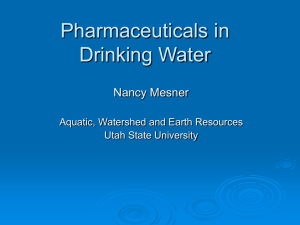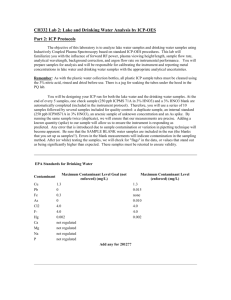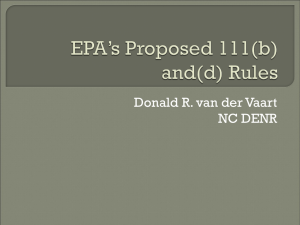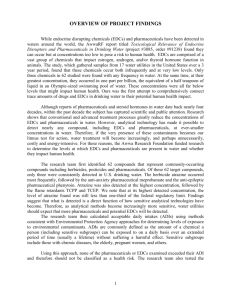Emerging Contaminants - National Association of Regulatory
advertisement
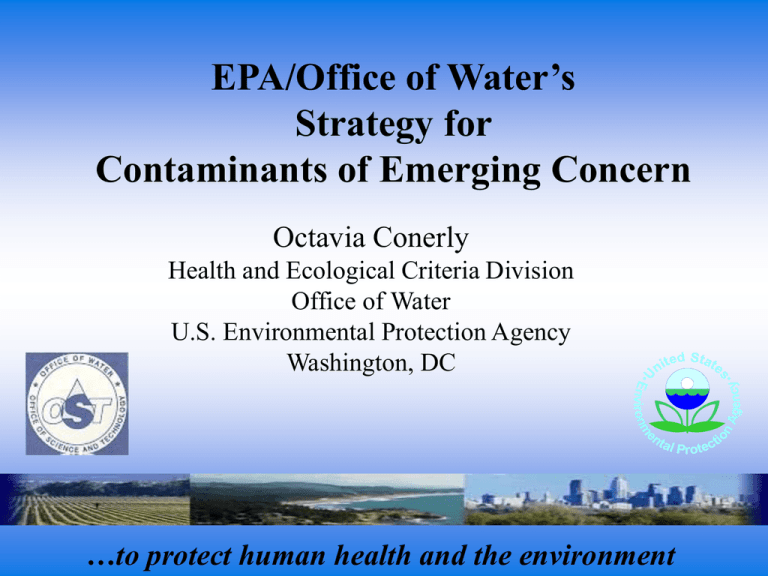
EPA/Office of Water’s Strategy for Contaminants of Emerging Concern Octavia Conerly Health and Ecological Criteria Division Office of Water U.S. Environmental Protection Agency Washington, DC …to protect human health and the environment Overview • Contaminants of emerging concern • Reason for concern • EPA’s four-pronged strategy • Unique challenges ahead …to protect human health and the environment Contaminants of Emerging Concern in Water* Pharmaceuticals and Personal Care Products PFOA Nanomaterials Pesticides Prions Endocrine Disrupting Compounds PBDEs *Not an exhaustive list. Pharmaceuticals of Concern • Pharmaceuticals • Prescription & overthe-counter therapeutic drugs • Veterinary medicine • Detected in Water • • • • • • • • Steroids/Hormones Antibiotics Antidepressants Analgesics Antimicrobials Statins Antiepileptics Antineoplastics Is there concern for Human Health? • Some studies have documented occurrence in low levels in source and finished drinking water. • Pharmaceuticals are designed to be biologically active at low levels. • An increase in the use of pharmaceuticals is anticipated as the US population gets older. • Associated risks to humans and the environment are uncertain. However, demonstrated presence has generated Congressional and public concern. EPA’s Four-Pronged Strategy 1) Strengthening our Scientific Knowledge • Identifying potential contaminants of concern in surface water and drinking water • Identifying information gaps and targeting collection of needed effects, dose, concentration, methods, and occurrence information 2) Improving Public Understanding and Risk Communication • Providing information to help the public understand the issues and inform policy choices 3) Building Partnerships for Stewardship • Working to prevent pharmaceuticals from entering water 4) Using Regulatory Tools • Using EPA’s regulatory tools when sufficient information exists 1. Strengthening our Scientific Knowledge: Methods Development • Analytical methods are lacking for most emerging contaminants • OST developed and released methods for analysis of ~100 pharmaceuticals, personal care products, steroids, and hormones in water, soil, sediment, and biosolids. – Methods 1694, 1698 and 1699 at www.epa.gov/waterscience/methods/method/other.html • Working on drinking water analytical methods Strengthening our Scientific Knowledge: Occurrence • EPA is conducting studies to understand the potential occurrence of pharmaceuticals in wastewater effluent, biosolids, and fish tissue: – Publicly Owned Treatment Works (POTW) Study (12/09) – Pilot Study of PPCPs in Fish Tissue (10/08) – Expanded Fish Tissue Study (12/10) – National Targeted Sewage Sludge Survey (9/08) – Grants (ongoing) 2. Improving Public Understanding and Risk Communication • General EPA PPCP website -- focus on research: www.epa.gov/ppcp/ • OW to improve website with additional information on PPCPs in water efforts 3. Building Partnerships for Stewardship • ONDCP/EPA/HHS issued drug disposal guidelines (2/07) • Pharmaceuticals in the Environment (PiE) Workgroup to coordinate federal research efforts • Other stewardship efforts supported by EPA include: – Grant to ARCHS in St. Louis ($150K) for take-back of non-controlled, unused medicines at pharmacies – Grant to University of Maine ($150K) for mail-back of unused medicines w/law enforcement involvement – Great Lakes Earth Week Challenge--grants funding 24 collection events (medicines, e-waste or both) -- 1M pill goal far exceeded – Grant to Albany Medical Center in NY (>$100K) to identify ways to better manage pharmaceutical waste and educate health professionals – California Statewide “No Drugs Down the Drain” campaign planned for October 4 – 11, 2008 supported by Region 9 Various Stewardship Efforts • Federal efforts – “Do not flush” guidelines (2/07) • EPA/ONDCP/DHHS – Drug Take-Back Pilot Studies • EPA/OCHPEE – Universal Waste Rule • EPA/OSW Building Partnerships (Cont.) • Letters to all States (state environmental & public health dept. directors) • Stakeholder listening sessions on PPCPs in water – – – – Environmental/NGOs (5/7/08) Drinking water/Wastewater Utilities (5/13/08) State Associations (5/14/08) Agricultural Associations (6/4/08) • Major Stakeholders’ Recommendations/Concerns – – – – – Human Health Effects – need better understanding of effects Risk Communication – need consistent, clear, concise message Take Back Programs – need more funding/support Drug Disposal Policy – need to revisit and clarify Monitoring programs – need funding 4. Using Regulatory Tools • If sufficient information exists, we will take action – – – – Health Services Study Contaminant Candidate List (CCL3) Unregulated Contaminant Monitoring Rule (UCMR) Ambient Water Quality Criteria for Human Health and Aquatic Life – Drinking Water Health Advisories – National Primary Drinking Water Regulations – Six-Year Review EPA Statutory Framework Safe Drinking Water Act Contaminant Candidate List (CCL) Six Year Review Health Advisories Unregulated Contaminant Monitoring Rule (UCMR) Clean Water Act Human Health and Aquatic Life Criteria Water Quality Standards Effluent Guidelines for point sources Concentrated Animal Feeding Operations (CAFOs) Food Quality Protection Act Endocrine Disruptors Screening Program (EDSP) Resource Conservation and Recovery Act Universal Waste Rule Toxics and Substances Control Act Premanufacture Notices (PMNs), High Production Volume (HPV) chemicals Federal Insecticide, Fungicide and Rodenticide Act Pesticide Registration and Re-registration Regulatory Determination Does the contaminant adversely affect public health? Regulate with NPDWR Is the contaminant known or likely to occur in PWSs with a frequency and at levels posing a threat to public health? Will regulation of the contaminant present a meaningful opportunity for health risk reduction? Unique Challenges Ahead • Nature of available data (adverse effect vs beneficial effect) • Limited access to toxicological data for human pharmaceuticals • Absence of chronic, low-dose exposure data • Lack of drug interactions (mixtures) data • Application of available risk assessment methods • Intersex fish – human health connection • Available analytical and removal methods Next Steps • Collaborate with Federal/non-Federal, and international partners in targeting timely research, monitoring, testing and risk analyses efforts to fill data gaps to support criteria development and regulatory actions
